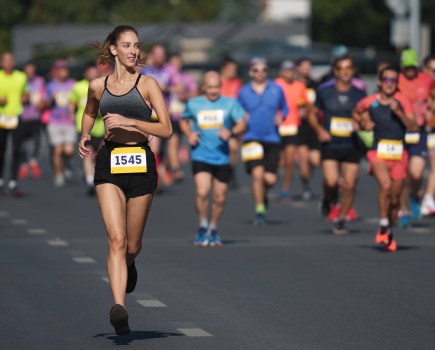Want to start running but don’t know how to get started or how far or fast to run? Christina Neal, author of the book ‘Run Yourself Fit’, has some top tips for new runners on taking those first steps.
The recent lockdown has not surprisingly resulted in a running boom, with the number of runners reported to have increased by 117 per cent according to a recent survey. With gyms closed for almost two months and people frustrated by the idea of being stuck at home, running has never been more popular.
And it’s easy to see why, even without the lockdown. Running is not only a great way to get fit but it’s a great calorie burner – it can torch around ten to 15 calories per minute depending on your age, weight, present fitness level and how fast you run. It also improves your heart health and reduces the risk of certain cancers and dementia. It’s also convenient, you can do it virtually anywhere and it’s cheap too. You don’t need lots of expensive equipment. What’s not to love?
That said, if you’re new to running, or you’ve not done it in a very long time, it can take a while to get back into it again and it may seem like a bit of a challenge at first. Here’s how to make your foray back into running fun and not too challenging…
Get the right shoes for you
One of the most important pieces of running kit is the right pair of shoes for you. Don’t be fooled by price or brand – you want to find the shoes that will complement your own unique running style and provide support where you need it. When you can, visit a specialist running store like Sweatshop, Runners Need or Run & Become (all of whom have branches in various locations) and get your running gait (style) analysed by a member of staff. Most staff in running stores are keen runners themselves and will be able to recommend the best type of shoes to support you.
Know your foot type
There are three different foot types – neutral arch, low arch and a high arch. If you have a low arch you are more likely to need a cushioned pair of running shoes as our arches act as shock absorbers when we run, cushioning us from the impact. If your arches are low, i.e. if you have flat feet, you may be more prone to injury as you will have less cushioning. In which case, a cushioned, supportive shoe may be best for you.
Invest in a supportive sports bra for running
The second piece of important kit for running is a high impact level sports bra designed to be worn when running. Shock Absorber, Enell (which makes sports bras for larger women) and Panache are all good brands but you can also buy a good running sports bra from Marks & Spencer and Sweaty Betty. Never run without wearing a sports bra as the ligaments in the breasts are inelastic, meaning that once they get stretched they remain that way, resulting in saggy boobs!
Start with a walk/run session at first
If it’s been a long time since you’ve run or you haven’t run before, don’t expect to go out and run continuously unless you’re already fairly fit. Start with a walk/run session – warm up with a brisk walk for around five minutes, ensuring you feel warm before you start, then jog for a minute, walk for a minute to recover and repeat this for up to 15-20 minutes depending on how you feel. Adjust the intervals to suit you. If it feels to difficult, jog for 30 seconds, walk for a minute and repeat. As you get fitter, the walking intervals can get shorter.
Don’t run on consecutive days
It’s not just your heart and lungs that need to get used to the demands of running – your joints, ligaments, muscles and tendons also need to adapt to this new activity. Make sure you have at least one day’s rest in between each run – you can’t still do other forms of low impact exercise such as walking, cycling or swimming, but don’t run every day. Running is a high impact activity, which means a force of at least three and a half times our bodyweight is absorbed through the joints when we run. Your body will need time to adapt and recover.
Build speed gradually
When you first start running, you may feel like you are running slowly but this really doesn’t matter. Don’t worry about speed. If you haven’t run since you were at school, it’s natural that you may find it a bit challenging at first. The good news is that it soon gets easier. Whatever you do, don’t go out and sprint like you’re running for a bus. Run at the speed of chat – you should be able to run at a pace that would enable you to chat if you had someone next to you. It’s a jog, not a sprint.
Stretch at the end of every run
Make sure you stretch the muscles in the legs including the quadriceps (front thighs), hamstrings (rear thighs), calves and also your glutes (butt) and lower back muscles, which can all get tight. Hold each stretch for at least 30 seconds.
Know that it will get easier
If you find those first few runs challenging, don’t be despondent. That’s normal when you haven’t run for a long time. When I first began running in my late 20s, I struggled to run for five minutes. I kept it up and within three weeks, I could run without stopping for 20 minutes. From there, I just kept going. It will get easier quickly. Aim to run three times a week with rest days in between and your stamina will soon improve.







